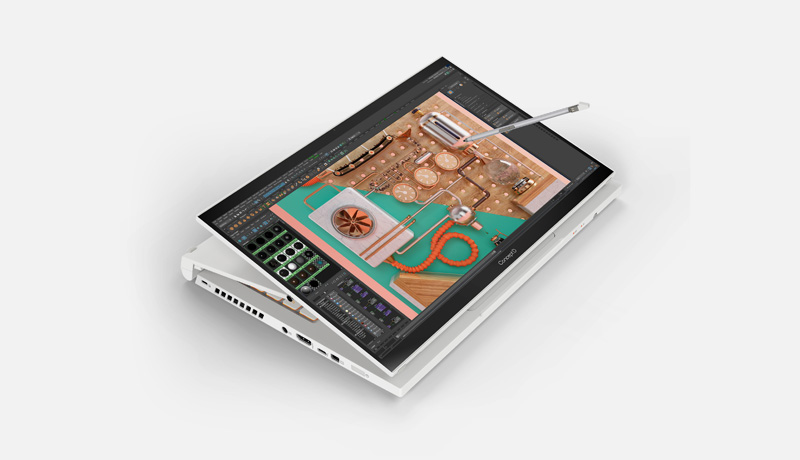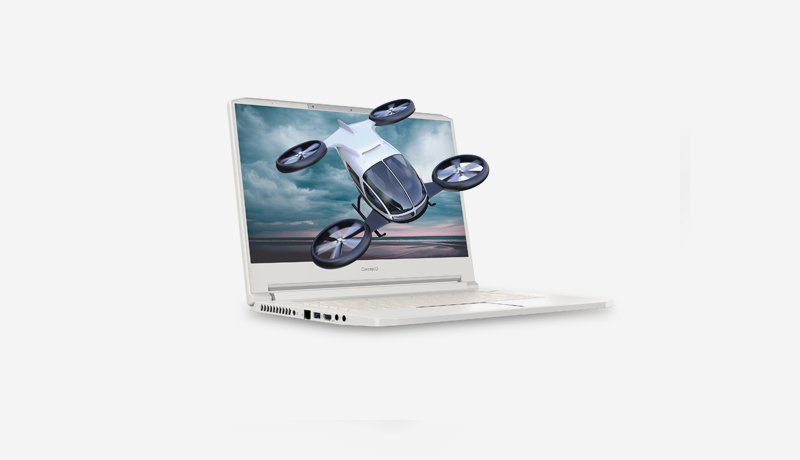
Acer has announced refreshes to each of its ConceptD creator notebook lines making it more powerful and dynamic than ever. As part of the update, Acer announced the introduction ofSpatialLabs™ to its ConceptD range, a suite of experiences empowered by cutting-edge optical solutions plus display and sensory technologies, that bring the virtual world to a more physical dimension. This technology enables content to literally float in front of the screen allowing creators to examine their creations in real-time and 360 degrees without the need for specialized glasses.
All ConceptD lines have been updated to include the new 11th Gen Intel®Core™H-series processors and a range of GPU options, including the NVIDIA® GeForce RTX™ 30 Series Laptop GPUs and the latest NVIDIA® RTX™ Professional Laptop GPUs powered by the NVIDIA Ampere architecture. They’re backed by the NVIDIA Studio ecosystem, as well as exclusive driver technology that enhances creative apps for optimal levels of performance and reliability.
The new ConceptD 5 notebooks also include a 16:10 16-inch display, providing enough space for content creators to view their videos and edit tracks without having to resize taskbars or hidepreview windows
Designed for 2D and 3Ddesign workflows, Acer’s all-metal ConceptD 5 notebooks (CN516-72G)pair the new 11thGen Intel®Core™ H-series processors withup to anNVIDIA® GeForce RTX™3060Laptop GPU. A ConceptD 5 Pro (CN516-72P)is also available, featuring either the NVIDIA® RTX™ A5000 or NVIDIA®RTX™ A3000 Laptop GPU, for creators looking for best-in-class performance and capabilities. The RTX A5000 Laptop GPU empowers creators with the ability to bring ray tracing and AI to the largest rendering, 8K editing, and multi-app workflows.
With up to 64 GB of DDR4 3200Hz memory and 2TB of PCIe Gen 4 M.2 SSDs in RAID 0, they provide all the power and storage creators need for handling 4K video, multiple monitors or 2D and 3D software rendering applications. Acer’s Vortex Flow, a triple-fan cooling layout(including a 5th Gen AeroBlade 3D Fan), is strategically organized to provide additional cooling to the CPU and GPU, allowinga bit more performance to be eked out under particularly demanding workloads.
Complementing all this power is a beautiful 16-inch 3K (3072×1920) PANTONE®-Validated display that supports 100%of the DCI-P3 color gamut,plusa color accuracy rating of Delta E<2.Its narrow bezel design provides an 87% screen to body ratio, while a 16:10 aspect ratio offers many benefits to professional creators. When compared to the more widely used 16:9 ratio, it is noticeably taller, giving creators more screen space for monitoring videos or utilizing multiple tracks without having to hide taskbars or resize preview windows.
The notebooks include a broad array of connectivity options: dual USB Type-C ports with Thunderbolt™ 4 support, HDMI 2.1, an SD card carder (SD7.0), and more. A silent keyboard and touchpad designed for noise reduction removes one further small distraction that could interrupt a user’s creative flow, and the6-inch wide Corning® Gorilla®Glass touchpad features a fingerprint reader for more convenient and secure logins.
The ConceptD 7 Ezel (CC715-72G), Acer’s flagship convertible creator notebook, has been updated to include the powerful new 11th Gen Intel® Core™ i7-11800H processor and up to an NVIDIA GeForce RTX 3080 Laptop GPU. A ConceptD 7 Ezel Pro (CC715-72P) is also available, featuring up to an Intel® Xeon®W-11955M processor and NVIDIA® RTX™ A5000 or A3000 Laptop GPUs for creators desiring even greater performance in professional applications and support.
Paired with up to 2TB PCIe SSDs and up to 32GB of DDR4 memory, it is an ideal choice for creators who typically handle large files and often use multiple applications at once. In addition, the newest models include dual Thunderbolt™4ports that offer 40Gbps bidirectional bandwidth, quicker transfer speeds, and the ability to connect up to five Thunderbolt devices—all with only one port. Lastly, a new ultra-responsive Corning Gorilla Glass touchpad makes navigation smooth and effortless.
Other key features include a brilliant 15.6-inch4K PANTONE-Validated touchscreen display that covers 100% of the Adobe® RGB color gamut and has a color accuracy rating of Delta E<2. Its adjustable display is enhancedby Acer’s innovative Ezel Hinge design which combines the familiarity and comfort of a traditional laptop with float, share, pad, stand and display modes that facilitate efficient and productive collaboration. It also includes a Wacom EMR pen,highly valued by artists who rely on the precision of a digital pen for sketching, animation and 3D modeling.
Acer also updated its ConceptD 3 line, which includes 14-inch convertible (CC314-72G) and traditional (CN314-72G)designs. A ConceptD 3 Pro(CN314-72P)and ConceptD 3 Ezel Pro(CC314-72P) are also available, both featuring up to an Intel® Core™ i7 processor capable of reaching 4.6 GHz and NVIDIA T1200 Laptop GPU.
All of the ConceptD 3 form factors and sizes have been updated to include an 11th Gen Intel Core H-series processor. Commercial and consumer models willship withvarious graphics options to suit a variety of workloads and specialties, including the new NVIDIA GeForce RTX 3050Ti GPU. All include a PCIe Gen 4 SSD and a Thunderbolt™4 port with power deliveryenabled for super-fast charging.
This series offers powerful specs and creator-focused features at mid-range price points. The convertible models include Acer’s innovative Ezel Hinge, allowing them to be used in various modes, as well as a touchscreen display and AES pen. All ConceptD 3 notebooks include FHD (1920×1080) Pantone-Validated displays with 100% sRGB coverage and a color accuracy rating of Delta E <2.
The SpatialLabs experience is created through the combination of an eye-tracking solution, a stereoscopic 3D display and real-time rendering technologies. The eye-tracking solution consists of a stereo camera set, located on top of the device, and tracks the position and movement of a user’s head and eyes. The display of the ConceptDSpatialLabs prototype notebook to be provided to participants of the developer program consists of a UHD 2D panel with a liquid crystal lenticular lens optically bonded on top of it, together forming an innovative module that can be switched back and forth between 2D and stereoscopic 3D views.
In combination, this allows graphics processing technology to display a different image to each of a viewer’s eyes, creating a stereoscopic 3D effect that allows content to float in front of the screen. Real-time rendering technologies allow creators to interact with 3D models when using applications in the SpatialLabs Experience Center, to review their creations inreal-time, enhancing the design workflow, and to present interactive and immersive projects—all in stereoscopic 3D.

This suite of technology is revolutionary for creators who work with 3D content. Designers typically work on 2D displays that provide only limited information about the depth of a 3D object or scene. SpatialLabs empowers creators with the ability to see their projects come to life in real time.
Traditionally, artists had to make multiple sketches from different angles to ensure that their characters were proportioned correctly. Computers improved on this process, but as it is difficult to judge 3D proportions on a 2D screen, much was still left to a designer’s judgment. The SpatialLabs Model Viewer eliminates this limitation by providing an additional dimension for designers to work with, right out-of-the-box: an intuitive 360-degree perspective in which models can be rotated, moved, or even dragged out of the screen, allowing all angles to be considered. Even when considering a model from the same angle, more information is available in a stereoscopic 3D representation than a 2D one.
Being able to see their creations in stereoscopic 3D at a 1:1 ratio speeds up the process of finding issues and ensuring that a 3D design matches their original concept design. For example, product designers can use the SpatialLabs Model Viewer to get an idea of what the item they are making will look like before investing the time and resources to print or tool it. Additionally, functions like the ability to change a model’s HDRI background allow them to be presented in a natural, realistic environment. This means that managers and team members are able to provide clearer feedback at each stage of a project, and customers can more easily visualize an item to ensure that it aligns with their expectations.
The ConceptDSpatialLabs prototype notebook’s display is set to 2D mode by default, enabling the device to be utilized as a normal notebook computer. Upon launching applications in the SpatialLabs Experience Center, stereoscopic 3D mode will be automatically switched on.
The SpatialLabs Experience Center is a launcher which includes a tutorial on using the technology, several shortcuts for applications, and installers for applications and add-ons. Currently, these applications include:
SpatialLabs also supports Unreal Engine, a real-time 3D tool that gives creators the freedom to realize their visions, empowering developers and teams to collaborate and iterate faster than ever before with no compromises in quality or scalability.
To help turn their imagination into reality, Acer will provide those admitted to the program with a ConceptDSpatialLabs prototype notebook for a period of three months—totally free of charge, freight included. Accepted applicants can use the provided device to create projects in Unreal Engine, and in exchange, the applicant should allow Acer to demo and exhibit these project(s) for one year. User feedback and an interview will also be gathered during the creation process for purposes including product development.